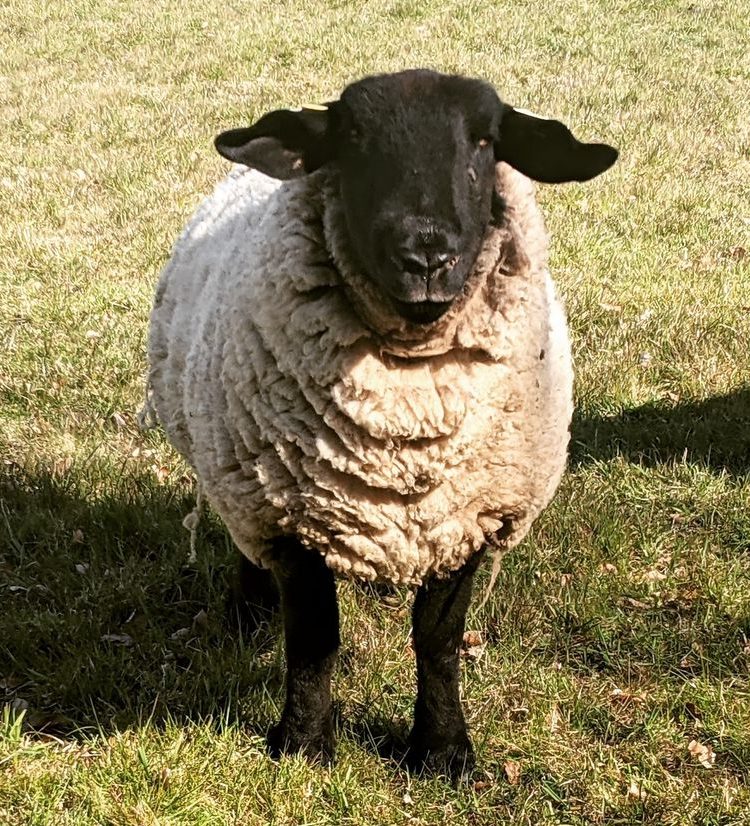As the name suggests, Suffolk sheep hail from the county of Suffolk in England. This beloved breed stretches back to the 1700s and has provided countless families with fresh mutton and warm wool.
If you’ve been looking to purchase backyard sheep or pasture stock, you’ll want to take a moment to consider these unique beauties. Like most all sheep, Suffolk sheep offer a good ROI and don’t take a lot of room to raise. They are hardy and resourceful animals.
Many small farmers and homesteaders looking to start raising livestock consider raising sheep because a flock is easy to care for. Suffolk lamb and mutton can be a reliable meat source for your family. In addition, you can sell their meat and wool for an additional income stream.
If you’re not familiar with sheep terminology, here’s a head’s up:
- Adult females are called ewes
- Males are known as rams
- Sheep that are less than a year old are lambs
Benefits of Raising Suffolk Sheep
Some sheep are raised for milk and cheese production. Others grow soft, bountiful wool. And others make excellent pets. Suffolk sheep are primarily used for two things:
- Meat Production
- Wool Production
Consequently, this breed could be an excellent choice for both ranchers and textile companies. However, Suffolk sheep also make exceptional pets, especially when kept in small manageable flocks. They are also a popular show sheep breed.
Let’s first review the two most prevalent benefits of raising Suffolk sheep: Meat and wool. Then we will discuss Suffolk milk production.
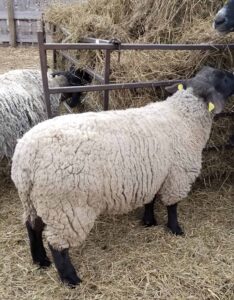
Meat Production
Suffolk sheep are a particularly muscular breed. As such, their meat tends to be lean, grassy, and slightly sweet. The lamb and mutton this breed produces are sought-after products.
Lambs tend to get sent to slaughter when they reach about 100 pounds or when they’re just under a year old. This Suffolk sheep meat is called lamb.
The meat is called mutton when the mature Suffolk ewe or ram is older than one year. When the Suffolk rams and ewes are slaughtered younger, when they are between 12 months and 20 months old, the meat is called yearly mutton.
Oftentimes, farmers will cull ewes after spring lambing. Suffolk sheep that aren’t used for meat tend to be utilized for their fast-growing, thick wool coats. Learn more about meat sheep breeds.
Wool Production
The majority of wool-producing Suffolk sheep are ewes. Rams also grow wool coats, but many are slaughtered while they are still lambs.
Ewes can produce almost eight pounds of wool during a single shearing, and rams may produce slightly more due to their bulkier builds. Suffolk sheep lifespan is up to 14 years, which means they will produce fleece for years.
Raw sheep’s wool has an average selling price of about $16 – 20 per pound. If you own a dozen Suffolk sheep ewes, that works out to approximately $1,200 in profits after selling the raw wool. These prices often increase if the wool is treated, dyed, or woven into textiles.
You can harvest a sheep’s wool about every six months, and lambs should be sheared at about six months of age. But it’s crucial to leave a six-week growth period when shearing in the autumn. Otherwise, your sheep might not be able to grow enough wool to keep themselves warm during the chilly winter months.
Learning how to shear a sheep is important though many sheep owners hire a professional.
Taking your sheep’s needs into consideration is crucial for raising them to be healthy, productive, and happy. Another excellent sheep breed to raise for wool fibers are Rambouillet sheep.
Milk Production
On a side note, the Suffolk ewe’s milk also fetches a competitive price. Some of the priciest gourmet cheeses throughout England and North America are derived from Suffolk sheep milk.
However, most of these sheep are raised and slaughtered for meat production. They are not considered to be a dairy sheep breed. Ewes will provide enough milk for your family but it may be difficult to find a market to sell the milk. This is in part because there aren’t facilities to process the milk on a commercial scale.
Advantages to Raising Suffolk
They are a hardy breed that provide high-quality meat and wool. In addition, they are easy to care for. They can successfully graze on scrubby pasture. You can easily supplement their grazing with hay and commercial grain for sheep. Their clean faces help minimize the chance for internal and external parasites. They are highly adaptable and can thrive in a variety of climates. In addition to the Suffolk breed being popular, another to consider is Texel sheep for their meat.
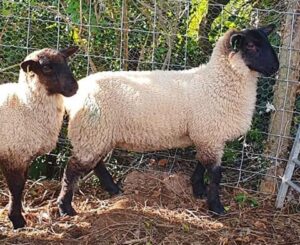
How to Raise Suffolk Sheep
Just like other breeds of sheep, Suffolk sheep are herbivores and grazers. They spend much of their days munching on whatever fresh vegetation is nearby. They especially prefer broadleaf weeds and plants and grasses close to the ground.
This makes them excellent all-natural lawnmowers. You’ll need to feed your sheep a steady supply of grass, hay, and weedy vegetation. Remember, sheep love to graze and forage for their meals. It might be wise to seed a field or plant a special garden before welcoming your new flock.
You’ll also need proper shelters them. Depending on your environment, you might only need a simple pole shelter. They are stocky, hardy animals. Still, those living in colder climates will want to invest in secure, insulated shelters such as barns. No matter where you live, they will need a place to be safe from predators and from harsh weather.
Suffolk sheep also need bi-annual shearing, monthly deworming, and hoof trimming services every two months or so. Some farmers and sheep keepers may also need to dock the tails of their sheep to prevent flystrike. However, docking may not be necessary for all herds.
They are already polled, so you won’t have to worry about horns. However, this can make them more vulnerable to predators. Having a livestock guardian dog or other livestock guardian animal such as a guard llama can help protect them. They are easy to herd.
Appearance and Weight
One of the most distinct qualities of Suffolk sheep is their appearance. They have white bodies and black faces, ears and legs. These sheep have jet-black skin and slightly blonde, cream-colored coats — more cream than white but most consider Suffolks to be black and white.
Their legs are bare of wool from about the knee upward, as are their heads. These sheep lack horns, unlike their genetic progenitors, Norfolk Horn sheep. Neither rams nor the ewes have horns.
You can use the chart below to learn more about average Suffolk sheep sizes and weights.
| Sex | Appearance | Suffolk Weight |
| Male / Ram | Wide body frame, boxy chest, dark beige wool color | 250 lbs – 350 lbs |
| Female / Ewe | Slim body frame, gentle chest slope, light blonde wool color | 180 lbs – 250 lbs |
Suffolk Sheep Reproduction and Lifespan
This domesticated breed lives between 10 – 13 years. When a ewe gets pregnant, it takes about 150 days for the lamb (or lambs) to gestate. Each ewe can produce between two and six lambs each year. Twins are common.
Consequently, if you start with nine ewes and one ram, you could end up with a flock of 360+ sheep in just one decade! But it’s crucial that each ewe should only breed twice per year.
That said, it’s also important to note that this breed is known for its easy birthing. Suffolk sheep have slim shoulders, and when ewes are giving birth, there are often few complications.
However, Suffolk sheep can begin reproducing at around six months of age when they are sexually mature. Pregnancies in sheep younger than eight months or a year can become complicated and result in unwanted injuries or death.
If you plan on raising a flock of Suffolk sheep, you’ll need to separate your lambs by gender when they reach about three or four months. Rams are highly fertile.
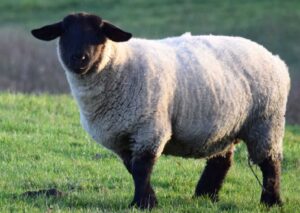
Why Are Suffolk Sheep Good Backyard Sheep?
This breed is one of the best farm animals to raise if you have land for them to graze. If you have a big property with an expansive backyard, you can consider purchasing a few sheep to help keep the weeds and grasses maintained.
However, choosing the best possible breed can be challenging. Suffolk sheep could be an excellent choice, particularly for those with:
- Several acres of open land
- Plenty of vegetation in their yard
- Tons of free time to spend caring for their sheep
- A passion for sheep rearing and shearing
- A desire to produce organic, local meat and wool
So long as you have at least one acre of space per six sheep, you can easily manage your flock and responsibilities. Learn how many sheep per acre you can keep.
Homeowners with shepherding dogs might be delighted to find that their daily sheep-raising tasks are far easier with a little four-legged help. After all, herding dogs have the instinct to round up stray sheep and keep livestock safe from predators.
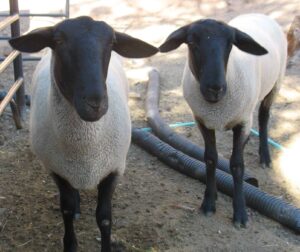
Exciting Facts About Suffolk Sheep
- They are a hybrid breed. They were initially created by mixing Southdown rams with Norfolk Horn ewes.
- Friendly and domesticated
- This breed has incredibly narrow shoulders, which may help lessen complications during the birthing process.
- The Suffolk Sheep Society dates back to 1886 and is still active to this day.
- They live to be 11 – 13 with proper care. Learn how long do sheep live and compare Suffolk to other sheep breeds.
Suffolk Sheep Origin
Regarding breed information, Suffolk sheep originate from Suffolk, England. They’re easily identifiable thanks to their striking black skin and creamy fleece coats.
While the majority of these sheep end up as mutton chops, some are kept for their wool. Additionally, some folks simply enjoy keeping Suffolk sheep as pets.
Still, you’ll need to provide plenty of vegetation and water to keep your flock happy. A livestock animal will help protect the herd or just a few Suffolks.
They’ll also need access to wide-open spaces and warm, enclosed shelters. However, this breed is known for its relatively quick and easy birthing, making it one of the hardiest breeds for ranchers.Join the United Suffolk Sheep Association (USSA) when you acquire this breed to get more info.
Suffolk Sheep Disadvantages
There are just a few disadvantages when it comes to raising Suffolk sheep. One is that its a prey animal. They lack the ability to defend themselves. Especially with this sheep breed without horns.
Consider what predators are in your area. Sheep predators include bobcats, coyotes, mountain lions, foxes, bears, etc. Eagles can also prey on sheep. Having a means to shepherd them to a secure shelter, especially at night — through a livestock guardian dog or other means — can go a long way toward keeping them safe.
Are Suffolk Sheep for You?
If you are just starting out with raising livestock or want to add new animals to your farm, consider Suffolk. They provide a sustainable meat source for you and your family. The fleece they provide is considered medium wool. With the internet, you can likely find a market to sell it if you can’t find a local market.
They are a popular domestic meat sheep breed to keep in the United States. These white sheep with black faces are large, friendly animals. As herbivores, they are excellent grazers. You can breed several lambs each year to have a continuous source of wool and meat.
Difference between sheep and goats to guide beginners
Learn about adding Icelandic sheep to your flock.
Sheep names – find your favorites

